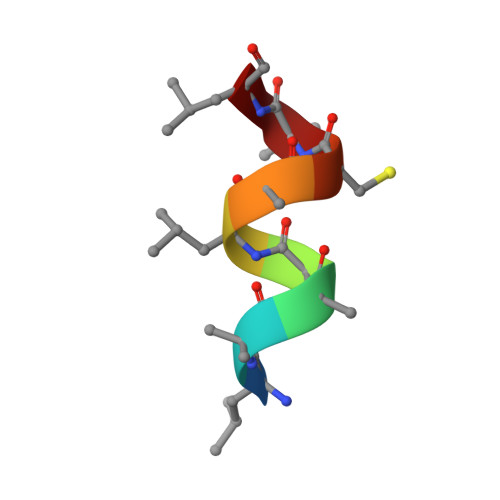Noncovalent Peptide Assembly Enables Crystalline, Permutable, and Reactive Thiol Frameworks.
Hess, S.S., Coppola, F., Dang, V.T., Tran, P.N., Mickel, P.J., Oktawiec, J., Ren, Z., Kral, P., Nguyen, A.I.(2023) J Am Chem Soc 145: 19588-19600
- PubMed: 37639365
- DOI: https://doi.org/10.1021/jacs.3c03645
- Primary Citation of Related Structures:
8GB9, 8GBA, 8GBH, 8GBI, 8GBM, 8GBO, 8GD6, 8GD8, 8GIV, 8GJ7, 8GK1, 8GK2, 8GK9, 8GKB, 8GKX, 8GL0, 8GL4, 8GL5, 8SW2, 8SY4 - PubMed Abstract:
Though thiols are exceptionally versatile, their high reactivity has also hindered the synthesis and characterization of well-defined thiol-containing porous materials. Leveraging the mild conditions of the noncovalent peptide assembly, we readily synthesized and characterized a number of frameworks with thiols displayed at many unique positions and in several permutations. Importantly, nearly all assemblies were structurally determined using single-crystal X-ray diffraction to reveal their rich sequence-structure landscape and the cooperative noncovalent interactions underlying their assembly. These observations and supporting molecular dynamics calculations enabled rational engineering by the positive and negative design of noncovalent interactions. Furthermore, the thiol-containing frameworks undergo diverse single-crystal-to-single-crystal reactions, including toxic metal ion coordination (e.g., Cd 2+ , Pb 2+ , and Hg 2+ ), selective uptake of Hg 2+ ions, and redox transformations. Notably, we find a framework that supports thiol-nitrosothiol interconversion, which is applicable for biocompatible nitric oxide delivery. The modularity, ease of synthesis, functionality, and well-defined nature of these peptide-based thiol frameworks are expected to accelerate the design of complex materials with reactive active sites.
Organizational Affiliation:
Department of Chemistry, University of Illinois Chicago, Chicago, Illinois 60607, United States.
















